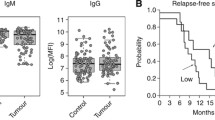Abstract
Initial studies have revealed an enhanced surface expression of O-acetylated sialoglycoconjugates (O-AcSGs) on lymphoblasts concomitant with high titres of IgG in childhood Acute Lymphoblastic Leukaemia (ALL) (Mandal C, Chatterjee M, Sinha D, Br J Haematol 110, 801–12, 2000). In our efforts to identify disease specific markers for ALL, we have affinity-purified IgM directed against O-AcSGs that reacts with three disease specific O-AcSGs present on membrane proteins derived from peripheral blood mononuclear cells (PBMC) of ALL patients. Antibody specificity towards O-AcSGs was confirmed by selective binding to erythrocytes bearing surface O-AcSGs, decreased binding with de-O-acetylated BSM and following pretreatment with O-acetyl esterase. Competitive inhibition ELISA demonstrated a higher avidity of IgM for O-AcSG than IgG. Flow cytometry demonstrated the diagnostic potential of purified O-AcSA IgM as binding was specific with ALL patients and minimal with other haematological disorders and normal individuals. It therefore may be adopted as a non-invasive approach for detection of childhood ALL. Taken together, the data indicates that carbohydrate epitopes having terminal O-AcSA α2 → 6 GalNAc determinants induce disease specific IgG and IgM, potentially useful molecular markers for childhood ALL.
Similar content being viewed by others
References
Mandal C, Chatterjee M, Sinha D, Investigation of 9-Oacetylated sialoglycoconjugates in childhood acute Lymphoblastic leukaemia, Br J Haematol 110, 801–12 (2000).
Kelm S, Schauer R, Sialic acids in molecular and cellular interactions, Int Rev Cytol 175, 137–240 (1997).
Schauer R, Chemistry metabolism and biological function of sialic acids, Adv Carb Chem Biochem 40, 131–234 (1982).
Varki A, Diversity in sialic acids, Glycobiology 2, 25–40 (1992).
Kamerling JP, Makovitzky J, Schauer R, Vliegenthart JF, Wember M, The nature of sialic acids in human lymphocytes, Biochim Biophys Acta 714, 351–5 (1982).
Schwartz-Albiez R, Carbohydrate and Lectin Section Leucocyte Typing VII, edited by Mason D, et al. (Oxford University Press, 2001), pp. 149–64.
Mandal C, Basu S, A unique specificity of a sialic acid binding lectin AchatininH from the hemolymph of Achatina fulica snail, Biochem Biophys Res Comm 148, 795–801 (1987).
Mandal C, Basu S, Mandal C, Physicochemical studies on achatininH a novel sialic acid binding lectin, Biochem J 257, 65–71 (1989).
Sen G, Mandal C, The specificity of the binding site of AchatininH a sialic-acid binding lectin from Achatina fulica, Carbohydr Res 268, 115–25 (1995).
Sen G, Chowdhury M, Mandal C, O-acetylated sialic acid as a distinct marker for differentiation between several leukemia erythrocytes, Mol Cell Biochem 136, 65–70 (1994).
Sharma V, Chatterjee M, Mandal C, Sen S, Basu D, Rapid diagnosis of Indian visceral leishmaniasis using achatininH, a 9-Oacetylated sialic acid binding lectin, Am J Trop Med Hyg 58, 551–4 (1998).
Sinha D, Mandal C, Bhattacharya DK, Identification of 9-O-acetyl sialoglycoconjugates (9-O-AcSGs) as biomarkers in childhood acute lymphoblastic leukemia using a lectin, Achatinin-H, as a probe, Leukemia 13, 119–25 (1999a).
Pal S, Chatterjee M, Bhattacharya DK, Bandhyopadhyay S, Mandal C, Identification and purification of cytolytic antibodies directed against O-acetylated sialic acid in childhood acute lymphoblastic leukemia, Glycobiology 10, 539–49 (2000).
Chatterjee M, Sharm V, Sundar S, Sen S, Mandal C, Identification of antibodies directed against O-acetylated sialic acids in visceral leishmaniasis, its diagnostic and prognostic role, Glycoconjugate J 15, 1141–7 (1998).
Sinha D, Chatterjee M, Mandal C, O-acetylated sialic acids-their detection biological significance and alteration in diseases, TIGG 12, 17–33 (2000).
Harris NL, Jaffe ES, Stein H, Banks PM, Chan JK, Cleary ML, Delsol G, De Wolf-Peeters C, Falini B, Gatter KC, A revised European-American classification of lymphoid neoplasms: A proposal from the International Lymphoma study group, Blood 84, 1361–92 (1994).
Siebert H-C, von der Lieth C-W, Dong X, Reuter G, Schauer R, Gabius H-J, Vliegenthart JF, Molecular dynamics-derived conformation and intramolecular interaction analysis of the N-acetyl-9-O-acetylneuraminic acid-containing gangliosideGD1a and NMR-based analysis of its binding to a human polyclonal immunoglobulin G fraction with selectivity for O-acetylated sialic acids, Glycobiology 6, 561–72 (1996).
Coligan EJ, Kruisbeek MA, Margulies HD, Shevach ME, Strober W, Current protocols in Immunology National Institute of Health 1 5.3.2–4 (1993).
Reuter G, Pfeil R, Stoll S, Schauer R, Kamerling JP, Versluis C, Vliegenthart JF, Identification of new sialic acids derived from glycoprotein of bovine submandibular gland, Eur J Biochem 134, 139–43 (1983).
Zimmer G, Reuter G, Schauer R, Use of influenza C virus for detection of 9-O-acetylated sialic acids on immobilized glycoconjugates by esterase activity, Eur J Biochem 204, 209–15 (1992).
Wu X, Okada N, Momota H, Irie RF, Okada H, Complementmediated anti-HIV-1 effect induced by human IgM monoclonal antibody against ganglioside GM2, J Immunol 162, 533–9 (1999).
Neale GA, Coustan-Smith E, Pan Q, Chen X, Gruhn B, Stow P, Behm FG, Pui CH, Campana D, Tandem application of flow cytometry and polymerase chain reaction for comprehensive detection of minimal residual disease in childhood acute lymphoblastic leukemia, Leukemia 13, 1221–6 (1999).
Sharma V, Chatterjee M, Sen G, Ch. Anil Kumar, Mandal C, Role of linkage specific 9-O-acetylated sialoglycoconjugates in activation of the alternate complement pathway in mammalian erythrocytes, Glycoconjugate J 17, 887–93 (2000).
Pui C-H, Childhood leukemias, N Engl J Med 332, 1618–30 (1995).
Chen J-S, Coustan-Smith E, Suzuki T, Neale GA, Mihara K, Pui C-H, Campana D, Identification of novel markers for monitoring minimal residual disease in acute lymphoblastic leukemia. Blood 97, 2115–20 (2001).
Campana D, Neale GA, Coustan-Smith E, Pui CH, Detection of minimal residual disease in acute lymphoblastic leukemia, the St Jude experience, Leukemia 15, 278–9 (2001).
Sinha D, Mandal C, Bhattacharya DK, A novel method for prognostic evaluation of childhood acute lymphoblastic leukemia, Leukemia 13, 309–12 (1999b).
Author information
Authors and Affiliations
Rights and permissions
About this article
Cite this article
Pal, S., Chatterjee, M., Bhattacharya, D.K. et al. O-acetyl sialic acid specific IgM in childhood acute lymphoblastic leukaemia. Glycoconj J 18, 529–537 (2001). https://doi.org/10.1023/A:1019692329568
Issue Date:
DOI: https://doi.org/10.1023/A:1019692329568




